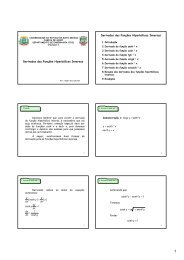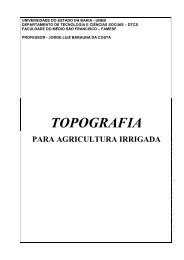Anuário Brasileiro do Arroz 2011 - Unemat
Anuário Brasileiro do Arroz 2011 - Unemat
Anuário Brasileiro do Arroz 2011 - Unemat
You also want an ePaper? Increase the reach of your titles
YUMPU automatically turns print PDFs into web optimized ePapers that Google loves.
Sílvio Ávila<br />
32<br />
A long way<br />
from equilibrium<br />
Brazilian market must adjust its prices to international<br />
standards if the production is to be shipped abroad and if<br />
the pressure induced by excessive supply is to be relieved<br />
Brazil’s 2010/<strong>2011</strong> bumper rice crop<br />
2010/1, which, according to figures released<br />
by the National Supply Company<br />
(Conab), reached 13.46 million tons,<br />
compared to the <strong>do</strong>mestic consumption<br />
of 12.8 million tons, resulted in<br />
market imbalance and serious producer<br />
concerns. The result of the harvest will<br />
not even be celebrated for its productive<br />
efficiency, seeing that the declining<br />
prices in the <strong>do</strong>mestic market, a<br />
phenomenon that started in late 2010,<br />
has affected the sector, triggered a<br />
trade crisis, annihilated farmers’ profits<br />
and caused losses. Not to mention that<br />
2010 had also been a difficult year.<br />
Up to May, the emergency mechanisms<br />
liberated by the Brazilian government<br />
had not shown strength enough<br />
to recover the prices. It is the case of<br />
the Premium per Output Flow (PEP),<br />
Federal Government Loan (EGF) and<br />
the Federal Acquisition (AGF) program.<br />
Pressure stemming from the exchange<br />
rate and supply was stronger that the<br />
government move to control the market,<br />
in spite of the soaring export levels<br />
at the beginning of the <strong>2011</strong>/12 commercial<br />
year.<br />
In light of this scenario, the sector is<br />
pressing the government for measures<br />
that guarantee the minimum price -<br />
R$ 25.80 per 50-kg sack of rice in the<br />
husk, Type 1, as set forth by law. As<br />
this price exceeds international parameters,<br />
it generates another problem:<br />
even if the mechanisms worked effectively,<br />
the value would pave the way for<br />
rice imports from the Mercosur bloc to<br />
flood into the Country. Signatory to the<br />
free trade agreement with the Mercosur<br />
bloc and a free market advocate, Brazil<br />
has no political or economic interest<br />
in blocking imports, although greatly<br />
required by all rice producers. But, on<br />
the other hand, the Country is getting<br />
to grips with the fact that something<br />
must be <strong>do</strong>ne as a manner to protect<br />
the sector and cushion the negative impact<br />
on the economy in South Brazil.<br />
To understand this scenario, it is<br />
necessary to clarify that, besides the<br />
new crop, interference is coming from<br />
the huge carryover stock in Brazil,<br />
reaching about 2.2 million tons, of<br />
which 950 thousand tons come from<br />
the grain carry over program of the<br />
federal government. The total stock<br />
increased by one million tons in one<br />
year, matching the amount of imports<br />
during the 2010/11 commercial year:<br />
1.04 million tons. The purchases were<br />
triggered by the competitive prices<br />
practiced in other Mercosur countries,<br />
while the cereal produced in South<br />
Brazil attracts no buyers because of<br />
heavy taxes levied on it, high production<br />
costs and the unfavorable exchange<br />
rate policy.



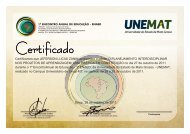
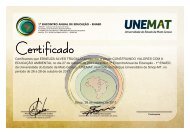
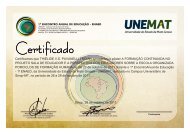
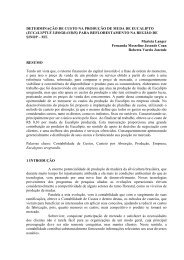
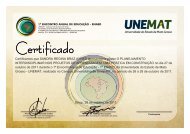
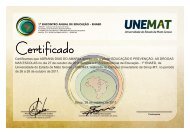
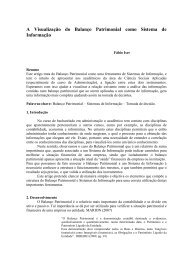
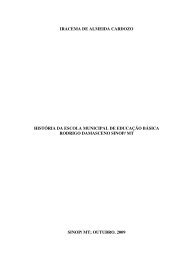

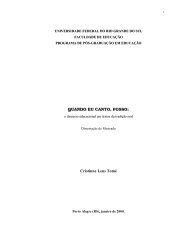
![Aula 31 - Funções Hiperbólicas [Modo de Compatibilidade] - Unemat](https://img.yumpu.com/14334654/1/184x260/aula-31-funcoes-hiperbolicas-modo-de-compatibilidade-unemat.jpg?quality=85)
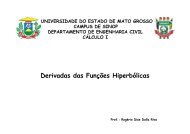
![Aula 31 - Funções Hiperbólicas [Modo de Compatibilidade] - Unemat](https://img.yumpu.com/14332146/1/190x135/aula-31-funcoes-hiperbolicas-modo-de-compatibilidade-unemat.jpg?quality=85)
